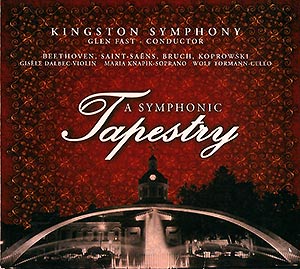compositions
compositions
TAPESTRIES of LOVE
movement III: Moment in Eternity - opening
Kingston Symphony
Conductor: Glen Fast
Soprano: Maria Knapik
CD
includes:
- Beethoven - Symphony No. 4
- Saint-Säens - Introduction & Rondo Capriccioso
- Bruch - Kol Nidrei
Conductor: Glen Fast
Kingston Symphony

Duration: 25 minutes
Written: 2006
Premiered: April 22, 2007
by Kingston Symphony
Conductor: Glen Fast
Soprano: Maria Knapik
Kingston, Canada
by Kingston Symphony
Conductor: Glen Fast
Soprano: Maria Knapik
Kingston, Canada
- Flute 1, Flute 2 (Piccolo)
- Oboe 1, Oboe 2 (English Horn)
- Clarinet 1 in Bb, Clarinet 2 in Bb (Bass Clarinet)
- 2 Bassoons
- 2 Trumpets in C
- 4 Horns in F
- 2 Trombones, Bass Trombone, Tuba
- Timpani
- Percussion 1, Percussion 2 {2 Crotales (sound two octaves higher), Glockenspiel (sounds two octaves higher), Vibraphone, Xylophone (sounds one octave higher), Marimba, Ratchet, Bell Tree, Glass Wind Chimes, Suspended Cymbal, pair of Cymbals in hand, Sizzle Cymbal, Tam-tam, Snare Drum, Bass Drum}
- Soprano Solo
- Strings (minimum one Double Bass with low C extension required)
Movements:
- Prelude to Love (Song of Enchantment)
- Time of Love
- Moment in Eternity
- “I have spread my dreams under your feet; tread softly, because you tread on my dreams”
Background
I was sixteen, immersed in the sometimes shocking avant-garde and “hip” trends of the day, when my first composition instructor cautioned me that “romantic” thoughts would slip into my compositions in the years to come – no matter how “modern” I wished my music to remain. Three years later I was further astonished when my professor at the Academy of Music predicted that in time I would show interest in vocal works.
They were both right! By 1971, under the influence of the polyphony of the Renaissance and professor Nadia Boulanger, I chose to “restore” a concept of melody into my work. Around the same time I declared (against all trends of the day), that extended tonality and the avant-garde techniques were not mutually exclusive. Driven by the thought of the supremacy of the overtone series combined with the concept of the Golden Proportion, I began the process of fusion of the time-honoured traditions with the provocative thoughts of the day. I thought of Szymanowski and Monteverdi as my models. While some influential individuals accused me of heresy, of deserting modernism, others forgot of my early output altogether. I was dumbfounded by the gradual loss of connection with the last 1000 years of the Great Tradition of Western Art Music. I chose to wait my turn, allowing myself to stay independent of the passing “currents” and popular trends. I wasn’t keeping with the chronology of the day. As a result of this thought, compositions like Canzona for 13 Soloists (1973) and Flute Concerto (1982), among others, were composed.
I yearned to further explore other “romantic” notions. For years I desired to write a composition on the subject of love. I kept searching for an inspiring text, which I found quite unexpectedly among the works of the Polish poet Stanislaw Trafinski. Although I chose to use only two poems, the composition saw a design in four movements. The two middle movements arose around the lines of the poems. The forth movement centered on the thought shared by the two poems – the thought of love and time.
The first movement became something of an enigma. Titled Prelude to Love (Song of Enchantment) it was composed last, late in 2006. Scored for orchestra alone, it sets the mood and the harmonic vocabulary of the whole composition. It is coy, longing, and provocative in turn.
The second movement Time of Love (Czas Milosci) and the third movement Moment in Eternity (Chwila Wiecznosci) were written in the first week of May 2006. The music reflects the poetry, which addresses various notions of love ranging from innocent love, through nostalgic love, to carnal love. Here the soprano soloist is put into the role of a narrator.
The fourth movement, “I have spread my dreams under your feet; tread gently, because you tread on my dreams” was written in the first week of December 2006, and was designed as a vocalise with a marked orchestral presence. It is lyrical, dramatic, and narrative in turn, and contains the climactic point of the whole composition. Various aspects of the previous movements are brought back in a fresh context, just as the whole composition is an expression of a Romantic Ideal in a fresh, XXI century context.
To honour the Great Tradition, the work does not fail to shadow the composers whose names have been so deeply engraved in our understanding of Romanticism: Richard Strauss and Richard Wagner.
The orchestral writing is demanding and virtuosic at times. The solo part enthrals and compels musical intelligence, sensitivity, and technical agility.
Tapestries of Love was commissioned by Maestro Glen Fast and the Kingston Symphony Orchestra for Maria Knapik, soprano, with financial assistance from the Ontario Arts Council.